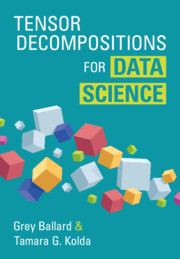Refine search
Actions for selected content:
48569 results in Computer Science
References
-
- Book:
- Machine Learning in Quantum Sciences
- Published online:
- 13 June 2025
- Print publication:
- 12 June 2025, pp 265-305
-
- Chapter
- Export citation
Contents
-
- Book:
- Machine Learning in Quantum Sciences
- Published online:
- 13 June 2025
- Print publication:
- 12 June 2025, pp vii-x
-
- Chapter
- Export citation
Preface
-
- Book:
- Machine Learning in Quantum Sciences
- Published online:
- 13 June 2025
- Print publication:
- 12 June 2025, pp xv-xvi
-
- Chapter
- Export citation
Acknowledgments
-
- Book:
- Machine Learning in Quantum Sciences
- Published online:
- 13 June 2025
- Print publication:
- 12 June 2025, pp xvii-xix
-
- Chapter
- Export citation
Index
-
- Book:
- Machine Learning in Quantum Sciences
- Published online:
- 13 June 2025
- Print publication:
- 12 June 2025, pp 306-308
-
- Chapter
- Export citation
A - Mathematical details on principal component analysis
-
- Book:
- Machine Learning in Quantum Sciences
- Published online:
- 13 June 2025
- Print publication:
- 12 June 2025, pp 258-259
-
- Chapter
- Export citation
Boundary objects in longevity planning service: exploring personas and dualities through constructivist grounded theory
-
- Journal:
- Design Science / Volume 11 / 2025
- Published online by Cambridge University Press:
- 11 June 2025, e17
-
- Article
-
- You have access
- Open access
- HTML
- Export citation
A Retrospective on Sound Space and Its Rhizomatic Genealogy
-
- Journal:
- Organised Sound , First View
- Published online by Cambridge University Press:
- 11 June 2025, pp. 1-9
-
- Article
- Export citation
Joining forces for online feedback management: policy recommendations for human–AI collaboration – CORRIGENDUM
-
- Journal:
- Data & Policy / Volume 7 / 2025
- Published online by Cambridge University Press:
- 09 June 2025, e42
-
- Article
-
- You have access
- Open access
- HTML
- Export citation

Tensor Decompositions for Data Science
-
- Published online:
- 05 June 2025
- Print publication:
- 26 June 2025
22 - Learning for Movement Actions
- from Part VII - Motion and Manipulation Models in Robotics
-
- Book:
- Acting, Planning, and Learning
- Published online:
- 19 May 2025
- Print publication:
- 05 June 2025, pp 526-534
-
- Chapter
- Export citation
Part VII - Motion and Manipulation Models in Robotics
-
- Book:
- Acting, Planning, and Learning
- Published online:
- 19 May 2025
- Print publication:
- 05 June 2025, pp 447-448
-
- Chapter
- Export citation
24 - Perceiving, Monitoring, and Goal Reasoning
- from Part VIII - Other Topics and Perspectives
-
- Book:
- Acting, Planning, and Learning
- Published online:
- 19 May 2025
- Print publication:
- 05 June 2025, pp 547-558
-
- Chapter
- Export citation
About the Authors
-
- Book:
- Acting, Planning, and Learning
- Published online:
- 19 May 2025
- Print publication:
- 05 June 2025, pp xii-xii
-
- Chapter
- Export citation
1 - Introduction
-
- Book:
- Acting, Planning, and Learning
- Published online:
- 19 May 2025
- Print publication:
- 05 June 2025, pp 1-10
-
- Chapter
- Export citation
2 - Reversible MCMC and Its Scaling
-
- Book:
- Scalable Monte Carlo for Bayesian Learning
- Published online:
- 16 May 2025
- Print publication:
- 05 June 2025, pp 39-61
-
- Chapter
- Export citation
12 - Planning with Nondeterministic Models
- from Part IV - Nondeterministic Models
-
- Book:
- Acting, Planning, and Learning
- Published online:
- 19 May 2025
- Print publication:
- 05 June 2025, pp 309-341
-
- Chapter
- Export citation
15 - Hierarchical Refinement Planning
- from Part V - Hierarchical Refinement Models
-
- Book:
- Acting, Planning, and Learning
- Published online:
- 19 May 2025
- Print publication:
- 05 June 2025, pp 368-379
-
- Chapter
- Export citation
Epigraph
-
- Book:
- Ethnography of an Interface
- Published online:
- 18 May 2025
- Print publication:
- 05 June 2025, pp v-vi
-
- Chapter
- Export citation
